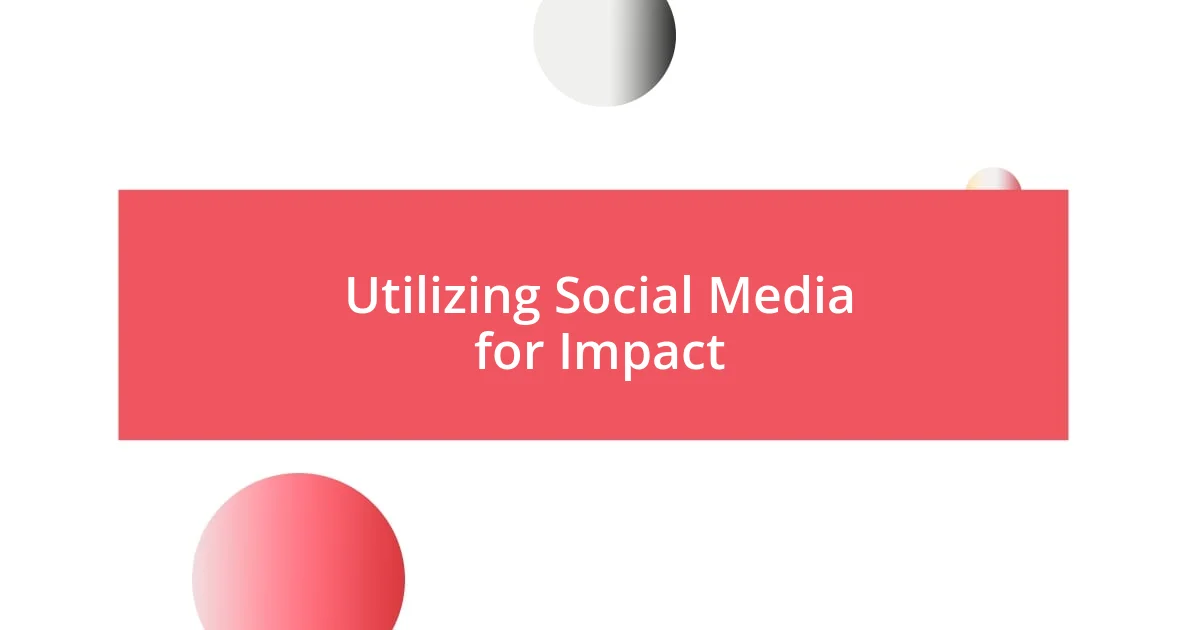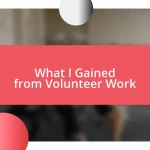Key takeaways:
- Understanding the difference between advocacy and awareness is crucial; awareness builds the foundation for effective advocacy.
- Developing personal advocacy skills involves storytelling, active listening, and consistency to establish genuine connections.
- Measuring advocacy success goes beyond statistics, focusing on personal impact, community engagement, and feedback from those served.

Understanding Advocacy and Awareness
Advocacy is more than just voicing support for a cause; it’s about taking action to drive change. I still remember the first time I stood in front of a community board meeting, heart racing, as I shared my story and the struggles many face daily. That experience made me realize just how powerful it is to advocate for those who might feel voiceless.
Awareness, on the other hand, is the foundation that advocacy builds upon. Have you ever found yourself moved by a cause you hadn’t previously considered? The moment I learned about the mental health stigma in my community, I felt a surge of emotion—this wasn’t just statistics; these were real people, possibly even friends or family, suffering in silence. This ignited a passion within me to shine a light on issues often hidden in the shadows.
Together, advocacy and awareness create a ripple effect that can transform lives. I think back to the various campaigns I’ve been a part of and how the shared stories helped others break free from isolation. Isn’t it incredible how a single conversation or post can inspire someone else to join the fight? It’s that connection—recognizing our shared humanity—that drives us forward.

Defining Your Cause and Purpose
Defining your cause and purpose is a deeply personal journey. It can often start with a conversation or a moment of realization that shifts your perspective. For me, it was during a volunteering event for a local shelter. As I listened to the stories of those experiencing homelessness, I felt a connection that shook me to my core. This emotional experience shaped my purpose and drove me to learn more about the systemic issues behind poverty, pushing me to advocate for change.
To help clarify your cause and purpose, consider the following steps:
- Reflect on your passions: What issues resonate with you on a personal level?
- Identify your strengths: What skills can you contribute to driving change?
- Connect with the community: Engaging with others facing similar struggles can deepen your understanding and commitment.
- Set clear goals: Define what success looks like for you and how you intend to measure your impact.
- Stay adaptable: As you grow, your understanding and focus may evolve, and that’s perfectly okay.
Each of these steps can guide you in honing a cause that truly reflects your values and experiences.

Developing Personal Advocacy Skills
Developing personal advocacy skills involves not just understanding your cause but also honing the ability to express it effectively. I vividly remember when I practiced telling my story to a small group for the first time. The nerves were intense, but the moment I shifted from worry to sharing my passion, I felt a wave of empowerment wash over me. This taught me that while knowledge is important, conveying that knowledge with authenticity is crucial for genuine connections.
Listening is another fundamental skill in advocacy. I once attended a workshop where we role-played listening exercises. Surprisingly, my initial instincts were to jump in with solutions. Instead, when I focused on truly hearing others’ experiences, I discovered the nuances of their struggles. This shift not only sharpened my empathic skills but also revealed how advocacy often starts from a place of understanding, rather than trying to fix a problem immediately.
Consistency in advocacy can be a game-changer. I remember one initiative where I posted weekly updates on social media regarding mental health resources. At first, I didn’t see much engagement, but as I continued, I was amazed by the messages I received from people sharing how those posts resonated with their personal challenges. This experience solidified that persistence in my advocacy makes a noticeable difference and can help build a community where individuals feel safe to speak up.
| Skill | Description |
|---|---|
| Storytelling | Sharing personal experiences to connect emotionally with others. |
| Listening | Truly understanding others’ needs and emotions to inform effective advocacy. |
| Consistency | Regularly engaging with your audience to build trust and community. |

Engaging with the Community
Engaging with the community is a transformative experience, and I’ve seen first-hand how simply showing up can make a profound difference. One day, while organizing a local cleanup event, I was struck by the camaraderie that blossomed among strangers. We all shared a common cause, and as we worked side by side, our individual motivations became one collective force. Have you ever experienced that moment when you realize you’re part of something bigger? It’s electrifying, isn’t it?
During my advocacy journey, I discovered the importance of being an active listener. At a community forum, I felt compelled to speak up, but I held back and chose to listen instead. The stories I heard were raw and powerful, opening my eyes to the struggles of those I thought I understood. It made me realize that I could only advocate effectively if I truly understood the community’s needs. Have you ever found that listening can reveal insights you never expected? I certainly have, and it underscored the power of empathy in building connections.
Finally, incorporating fun and creativity into community engagement can spark enthusiasm. I once threw a themed awareness party in my neighborhood. We used art and music to draw people in, and I was surprised to see how it transformed an often serious discussion into something approachable. People were more willing to express their thoughts and share their experiences in such a relaxed environment. Isn’t it amazing how creativity can break down barriers? I believe it’s essential to infuse joy and passion into our advocacy efforts to foster lasting relationships within the community.

Utilizing Social Media for Impact
Utilizing social media for advocacy has been a game changer in my journey. I remember the excitement when I first shared my story online, accompanied by a heartfelt photo. The responses rolled in, ranging from support to others sharing their own experiences. This moment illustrated to me how powerful social media can be—it’s not just about broadcasting your message; it’s about creating a dialogue. Have you ever hit “post,” held your breath, and then felt an overwhelming sense of support from unexpected corners? That’s the beauty of it.
As I navigated through various platforms, I realized that engagement requires authenticity. I participated in a Twitter chat on mental health awareness, where I shared my journey with vulnerability. The conversation flowed, and I found myself connecting with strangers who felt seen and heard. It taught me that when you present your truth, you invite others to do the same. Doesn’t it feel amazing when a simple tweet can resonate deeply with someone across the globe? Social media fosters these connections that can transform individual struggles into a collective narrative.
Lastly, I found that utilizing visual content on social media can amplify impact significantly. One day, I decided to create an infographic that highlighted mental health statistics in my community. The response was phenomenal, far beyond what I anticipated. People began sharing it widely, triggering discussions that I had hoped to spark. It made me think, how can something so simple as an image turn into a tool for awareness and change? Visual storytelling can be incredibly effective, as it not only captures attention but also conveys important information in a digestible manner.

Building Alliances and Networks
Building alliances and networks has significantly shaped my advocacy journey. I recall a moment when I reached out to a local non-profit organization for a collaboration on a community health fair. What started as a simple request blossomed into a partnership that not only amplified our outreach but also forged lasting friendships with dedicated individuals who shared my passion. Have you ever experienced the synergy that comes from working with others towards a shared goal? It’s a remarkable feeling to realize that together, our impact can be much greater than any of us could achieve alone.
One of the most rewarding aspects of building these alliances has been attending networking events. Initially, I felt shy and uncertain, but I pushed myself to engage, sharing my story and listening to others. It amazed me how many people empathized and wanted to join forces. I vividly remember meeting a fellow advocate who became a mentor to me, guiding me on best practices and introducing me to her own expansive network. Has there ever been someone in your life who opened doors you didn’t even know existed? The right connections can truly illuminate paths forward.
In addition to formal networks, I’ve found that informal connections within my community can be just as powerful. I often attend local coffee meet-ups where passionate individuals gather to discuss issues close to their hearts. One evening, I met someone who had been working on environmental justice initiatives. We exchanged ideas, and it sparked a project that merged our interests, bringing fresh energy to both of our causes. These casual interactions remind me that advocacy can flourish in diverse settings—sometimes, all it takes is a cup of coffee and an open heart to spark something wonderful. How do you build connections in your own life? Each conversation holds the potential for collaboration and growth.

Measuring Your Advocacy Success
Measuring advocacy success is not just about tallies or statistics; it’s often about personal impact and emotional connections. For instance, the first time I received a heartfelt message from someone who felt empowered to share their own story after hearing mine, it struck me. How do you put a number on the profound feeling of making someone feel less alone? That moment was a tangible measure of success for me, reminding me that advocacy goes beyond numbers.
When I reflect on my advocacy efforts, I often consider the reach of my message across different platforms. On one occasion, a post I shared about mental health resources went viral, leading to countless shares and engagements. I was overwhelmed by the conversations it ignited—people began discussing their own challenges and the support they found through our community. What does it mean to amplify your voice when so many others join in? It’s a powerful experience to realize the ripple effect your words can create.
I’ve also learned that feedback is an invaluable tool for measuring success. After hosting a workshop on advocacy strategies, I took the time to survey participants. Their responses revealed not only what resonated with them but also areas for improvement. It made me ask, how can we truly measure our effectiveness if we don’t listen to those we aim to serve? Engaging with your audience fosters growth, creating a space for dialogue that can dramatically shape future advocacy efforts.















